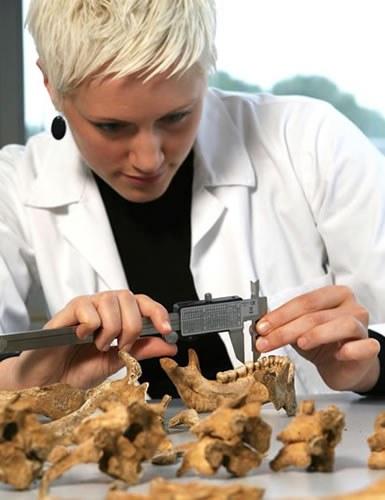
A Scientific Analysis of Ancient Human Remains from Ballyshannon, County Donegal
The Ballyhanna Project, is a major research partnership between the School of Science, Institute of Technology Sligo and the Department of Archaeology and Paleoecology, Queen’s University Belfast. The proejct .came about as a result of the discovery of an unknown medieval cemetery in Ballyshannon, Co Donegal unearthed as part of an excavation on a section of a new stretch of motorway by the National Roads Authority ( NRA).
The project is funded by the National Roads Authority.
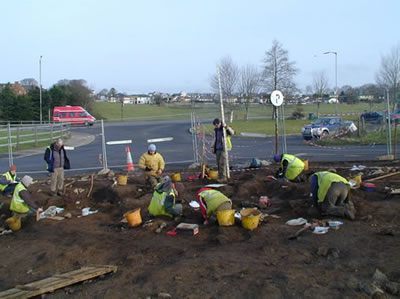
Excavations at the Ballyhanna Cemetery
Context
Archaeological test excavations carried out in 2003 along the proposed N15 Bundoran-Ballyshannon bypass resulted in the discovery of the ruined remains of an unknown medieval church and graveyard in Ballyhanna on the outskirts of Ballyshannon, County Donegal.
Among largest amount of medieval remains ever excavated in Ireland
Subsequent excavations over the course of 6 months in 2003/4 resulted in the full excavation of approximately 1286 human skeletons, in various states of preservation including a significant number of juveniles. This represents one of the largest assemblages of medieval human remains ever excavated in Ireland.
the skeletal assemblages are thought to date from the 11th-13th century AD. Exact dates of the various phases of burial will be confirmed by Carbon 14 dating which will be carried out at Queen’s University Belfast as part of the project this year.
The remains are currently curated in Institute of Technology Sligo. There are currently two Scientists and one Archaeologist employed on the project. The three principle areas of the project include Osteological Analysis, Archaeological Chemistry and Biomolecular Archaeology.
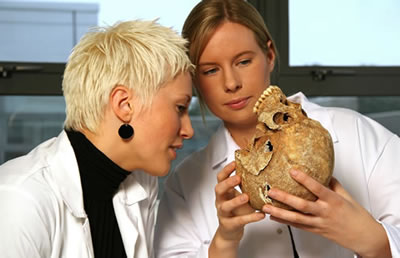
Skull analysis…
Osteological Analysis
Research Student: Ms Catriona McKensie
Supervisor: Dr Eileen Murphy
Research Assistant completed: Ms Roisin McCarthy
Catriona McKenzie, who is currently undertaking her PhD research on the adult skeletons from Ballyhanna, has now completed the analysis of these c. 850 individuals. She was assisted with this task by Roisin McCarthy.
Dr Eileen Murphy has completed the osteological analysis of the c. 350 non-adult skeletons, with the assistance of Claire McGranaghan at Queen’s University Belfast.
Considerable evidence of TB
Among the most interesting findings, were numerous cases of tuberculosis amongst the adults. In addition, at least one child displayed lesions characteristic of the disease – the lesions had affected his/her entire skeleton and had caused major destructive changes. It is probable that he/she would have died as a consequence of the disease. It is intended to undertake DNA work on these cases to see if we can learn more about the pathogen that had infected the people at Ballyhanna- for example, had they suffered from the animal (caused primarily by Mycobacterium bovis) or human (caused by Mycobacterium tuberculosis) form of the disease. This work will be undertaken in conjunction with Dr Jeremy Bird and Sheila Tierney at IT Sligo and Dr Mike Taylor of University College London.
Also interesting was the fact that some individuals showed signs of major bone destruction due to general infections. In a number of cases these gross infections would probably have been secondary to an injury, such as a compound fracture. It would seem in these cases that the infections had overwhelmed the individuals and had probably been the cause of their death. Unlike modern Irish people, the Ballyhanna individuals would not have had the luxury of treating infections with antibiotics.
Scurvy due to lack of vitamin C
Numerous young children displayed lesions characteristic of scurvy. This condition is due to vitamin C deficiency and is often associated with sailors in the past, whose long trips at sea prevented their access to fresh fruit and vegetables.
The evidence of scurvy and the frequent signs of childhood iron deficiency anaemia have the potential to provide major insights concerning childhood diet and health. Previously, definitive cases of scurvy have rarely been identified in the archaeological record for Ireland.
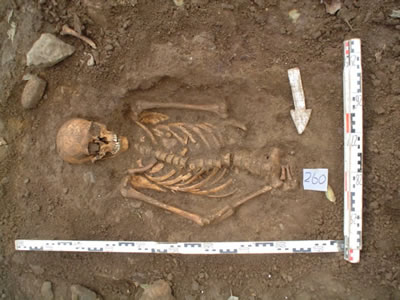
Ballyhana Skeleton
Two individuals displayed the characteristic lesions of multiple hereditary exostoses (otherwise known as diaphyseal aclasia), which causes large growths to occur at the ends of the bones, and is colloquially known as ‘bumpy bone’ disease. The condition is known to have a definite genetic origin and it generally affects more than one member of a family. Modern sufferers are known to experience pain at the sites of the lesions, interference with normal movement, impinged nerves – including compression of the spinal cord – and the risk that the bone growths would become cancerous.
The presence of two individuals with the condition at Ballyhanna raises many interesting questions concerning the attitudes of that society to the disabled as well as evidence for possible family relationships.
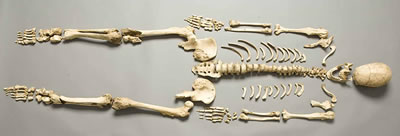
Skeleton from Ballyhanna
Trauma injuries caused by weapons
Quite a number of the adults displayed evidence of trauma – in most cases the presence of clear cut and chop marks on the bones suggests the blows had been dealt with bladed instruments, such as swords and knives. In addition to the affected adults, three teenage boys also displayed signs of weapon injuries and this may help provide us with an insight as to the age when individuals became eligible to fight … although it is of course possible that they were simply the victims of attack rather than active fighters themselves.
Moving into a new phase – Formulating overall impressions
Work on this major population is ongoing and is not due for completion until 2010. Now that the analysis is complete it is necessary to synthesise and undertake statistical analysis on the results so that we can gain an overall impression about how many individuals were affected by particular diseases, and address questions including, differences in how males and females or the different age groups were affected by the different diseases. We will also be undertaking x-ray analysis of individuals with particular diseases so we can gain a more detailed understanding of how the lesions have affected the bones. Another main objective at this stage of the project is to refine the chronology of the site by obtaining radiocarbon dates from a number of the individuals. This work will be undertaken in the CHRONO laboratory of Queen’s University Belfast imminently. The osteological research has shown that all members of society are represented at Ballyhanna – from premature babies to the elderly – and we believe the results really have the potential to provide major insights concerning the lives and deaths of the people buried at Ballyhanna.
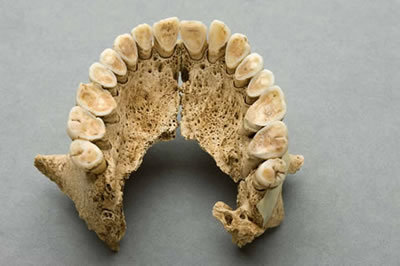
Skeletal remains of lower jaw from Ballyhanna
Biomolecular Analysis
Research Student: Ms. Sheila Tierney
Supervisor: Dr. Jeremy Bird
The aim of this research was to extract and amplify ancient DNA (aDNA) from the archaeological skeletal remains excavated from this cemetery. Our hope was that by using a biomolecular approach we would be able to establish a simple method of sexing individuals in skeletal assemblages, with specific interest in juvenile remains which may not be reliably sexed by conventional osteological methods.
Determining the sex of human remains relies on recording the differences between male and female skeletons, the pelvis and the skull being the main sex indicators. However morphological sex determination can only be conducted with an acceptable degree of accuracy on adult skeletons. Sexing juvenile and fragmentary skeletal human remains using existing osteological methods can provide ambiguous and unreliable results. At the age of puberty males and females begin to develop differences in the pelvis, and it is these differences that can later be used by osteologists to identify the sex of an adult individual. Before this age, however, juveniles exhibit little sexual dimorphism, which means that the skeleton of a young male will not differ substantially from that of a young female.
Fragmentary adult remains, on the other hand, may lack the crucial sex indicators that are needed to determine their sex. Developments in molecular biology in recent years have provided methods for extracting and analyzing DNA from archaeological remains and thus have presented archaeologists with the opportunity to establish the sex of such assemblages using DNA analysis.
As there is currently no existing osteoarchaeological methods that can accurately sex juvenile human remains, using DNA based sex identification methods such as PCR, Agarose gel electrophoresis and Real Time PCR, are ideal methodologies to aid in the sex determination of human juvenile remains.
Ancient DNA analysis
‘Ancient DNA’ is the term which describes DNA fragments that are recovered from archaeological and palaeontological remains. This technique of retrieving DNA from such ancient or archaeological sources has been typically called ancient DNA analysis (aDNA analysis). Ancient DNA analysis has developed exponentially ever since its birth more than twenty years ago. Methods developed in this research area have not only benefited archaeology but have also had an affect on population genetics, forensics, conservation biology, spread of infectious diseases and medicine.
Research Objectives:
- Analysis of a selected number of adult assemblages from Ballyhanna for the presence of ancient DNA.
- Validate methodology for PCR based sex identification by amplification of the amelogenin gene on X and Y chromosomes on assemblages of known sex.
- Confirmation of the X and Y amelogenin allele identities.
- Determine sex of juvenile assemblages using the validated PCR amelogenin amplification.
- Quantify ancient DNA using Real-Time PCR
Archaeological Chemical Analysis
Research Student: Ms. Tasneem Bashir
Supervisor: Dr. Ted McGowan
Enquiries to:
Dr Jeremy Bird,
School of Science,
Institute of Technology,
Sligo
Email: bird.jerry@nullitsligo.ie